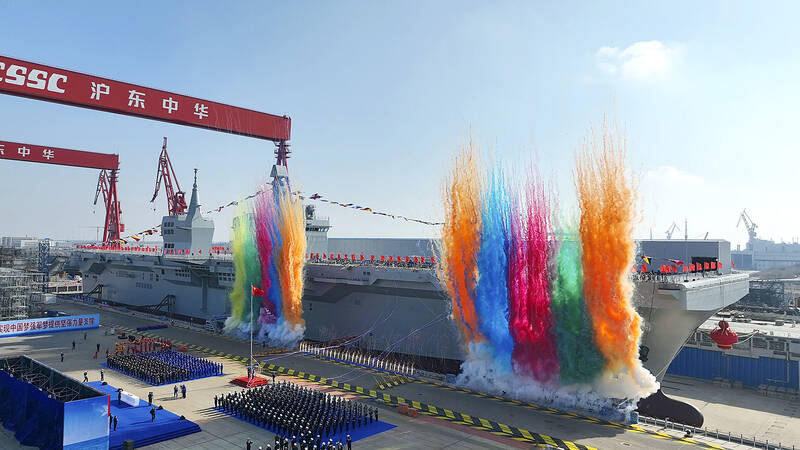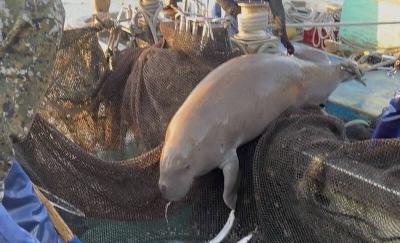China’s newest Type-076 amphibious assault ship has two strengths and weaknesses, wrote a Taiwanese defense expert, adding that further observations of its capabilities are warranted.
Jiang Hsin-biao (江炘杓), an assistant researcher at the National Defense and Security Research Institute, made the comments in a report recently published by the institute about the Chinese Communist Party’s (CCP) military and political development.
China christened its new assault ship Sichuan in a ceremony on Dec. 27 last year at Shanghai’s Hudong Shipyard, China’s Xinhua news agency reported.

Photo: EPA-EFE
“The vessel, described as the world’s largest amphibious assault ship by the [US think tank] Center for Strategic and International Studies, brings more air power to China’s navy as the Asian nation confronts flash points in the South China Sea and in the Taiwan Strait,” Bloomberg reported on Dec. 27.
China has continued developing its amphibious landing capabilities since 2017, resulting in the construction of the Type-075 Hainan and its newest ship, the Type-076 Sichuan, Jiang said.
The Sichuan is most known for being equipped with an electromagnetic catapult and three arresting cables, allowing the ship to carry and launch fix-winged planes.
Along with its armed helicopters and drones, this equipment gives the ship more versatility in aerial power projection, Jiang said.
The ship’s ability to serve in multiple roles — anti-air, anti-submarine, ranged strikes on land targets and amphibious landings — serves to enhance the Chinese People’s Liberation Army Navy’s maritime power projection, he said.
However, while the electromagnetic catapult and ability to launch fixed-winged aircraft enhances the ship’s anti-access/area denial capabilities, the efficacy of its take-off and landing operations would be affected, as the landing and take-off areas overlap, the report said.
The assisted landing and arresting systems are still subpar compared with those on aircraft carriers, the report added.
China is building up its navy’s amphibious combat capabilities and attempting to create a combat system similar to the US’ joint all-domain command and control framework, which aims at enhancing military effectiveness by integrating operations across all domains of warfare.
The Sichuan ship exceeds the Hainan in tonnage and is expected to displace 50,000 tonnes of water when fully equipped, and has 13,000m2 of deck space, the report said.
Powered by twin gas turbines, the ship’s speed would match that of China’s naval carriers, while its twin-island design allows it to help direct the carriers’ aircraft, it said.

‘DENIAL DEFENSE’: The US would increase its military presence with uncrewed ships, and submarines, while boosting defense in the Indo-Pacific, a Pete Hegseth memo said The US is reorienting its military strategy to focus primarily on deterring a potential Chinese invasion of Taiwan, a memo signed by US Secretary of Defense Pete Hegseth showed. The memo also called on Taiwan to increase its defense spending. The document, known as the “Interim National Defense Strategic Guidance,” was distributed this month and detailed the national defense plans of US President Donald Trump’s administration, an article in the Washington Post said on Saturday. It outlines how the US can prepare for a potential war with China and defend itself from threats in the “near abroad,” including Greenland and the Panama

A wild live dugong was found in Taiwan for the first time in 88 years, after it was accidentally caught by a fisher’s net on Tuesday in Yilan County’s Fenniaolin (粉鳥林). This is the first sighting of the species in Taiwan since 1937, having already been considered “extinct” in the country and considered as “vulnerable” by the International Union for Conservation of Nature. A fisher surnamed Chen (陳) went to Fenniaolin to collect the fish in his netting, but instead caught a 3m long, 500kg dugong. The fisher released the animal back into the wild, not realizing it was an endangered species at

The Chinese Nationalist Party (KMT) is maintaining close ties with Beijing, the Democratic Progressive Party (DPP) said yesterday, hours after a new round of Chinese military drills in the Taiwan Strait began. Political parties in a democracy have a responsibility to be loyal to the nation and defend its sovereignty, DPP spokesman Justin Wu (吳崢) told a news conference in Taipei. His comments came hours after Beijing announced via Chinese state media that the Chinese People’s Liberation Army’s Eastern Theater Command was holding large-scale drills simulating a multi-pronged attack on Taiwan. Contrary to the KMT’s claims that it is staunchly anti-communist, KMT Deputy

The High Prosecutors’ Office yesterday withdrew an appeal against the acquittal of a former bank manager 22 years after his death, marking Taiwan’s first instance of prosecutors rendering posthumous justice to a wrongfully convicted defendant. Chu Ching-en (諸慶恩) — formerly a manager at the Taipei branch of BNP Paribas — was in 1999 accused by Weng Mao-chung (翁茂鍾), then-president of Chia Her Industrial Co, of forging a request for a fixed deposit of US$10 million by I-Hwa Industrial Co, a subsidiary of Chia Her, which was used as collateral. Chu was ruled not guilty in the first trial, but was found guilty